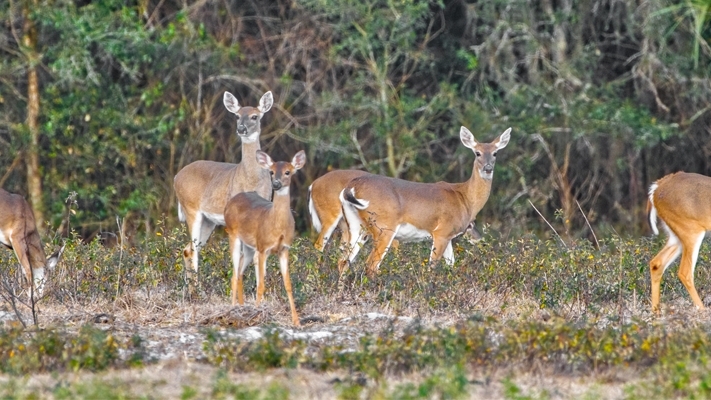Chronic Wasting Disease

Chronic wasting disease (CWD) is a deadly, neurological illness that affects deer, elk, moose, reindeer, and muntjac. It may also affect some other members of the Cervidae family.
Unlike most infectious diseases, CWD isn't caused by bacteria or a virus, but rather by misfolded natural proteins called prions. When these proteins fold incorrectly, they kill brain cells. Infected animals appear healthy for months or years. During this 'silent' incubation period, infected animals can transmit the disease to other animals. In the final stages of disease, animals become debilitated and ultimately die. How fast CWD progresses depends on the species and the animal's genetics.
Other diseases may present in a similar manner, so post-mortem testing is required to verify CWD. Here's what to look for:
- Weight loss
- Frequent urination
- Poor coordination
- Drooping ears
- Drooling
- Difficulty swallowing
- Aspiration pneumonia
Practice Biosecurity
CWD is a disease of the central nervous system caused by a prion that often presents as wasting. You can reduce the risk of CWD spreading to and infecting a farmed cervid herd by maintaining strict biosecurity. If you are just starting to raise farmed cervids consider raising a species that is not known to be susceptible to CWD. For white-tailed deer herds, you can reduce CWD spread by breeding for less susceptible animals.
Learn More About Biosecurity and CWD
Enroll in the Voluntary Herd Certification Program
We also encourage producers to enroll in the CWD Herd Certification Program. The goal of the program is to provide a consistent, national approach to control the incidence of CWD in farmed cervids and prevent the interstate spread of CWD.
Predictive Genetics
Learn More About Predictive Genetics
Report Signs of Animal Disease
Producers or owners who suspect an animal disease should contact their veterinarian to evaluate the animal or herd. Find an accredited veterinarian.
Animal health professionals (veterinarians; diagnostic laboratories; public health, zoo, or wildlife personnel; and others) report diagnosed or suspected cases of nationally listed reportable animal diseases to APHIS Area Veterinarians in Charge and to the State animal health official as applicable under State reporting regulations.
Controlling Chronic Wasting Disease
APHIS' National CWD Voluntary Herd Certification Program provides a consistent national approach to control the incidence of CWD in farmed cervids and prevent its spread interstate. Cervid herds must participate in the program and be certified to move animals interstate.
- Collection Card (184.18 KB): This offers a pictorial guide for proper post-mortem sample collection for CWD.
- APHIS-Approved Testing Laboratories: Use this list to locate labs in your area that can conduct testing to verify CWD. Contact the laboratory before submitting samples to ensure they have funding available to conduct the test.
APHIS Wildlife Services conducts surveillance and research on dozens of wildlife diseases, including chronic wasting disease. For more information, visit our National Wildlife Disease Program and National Wildlife Research Center.


